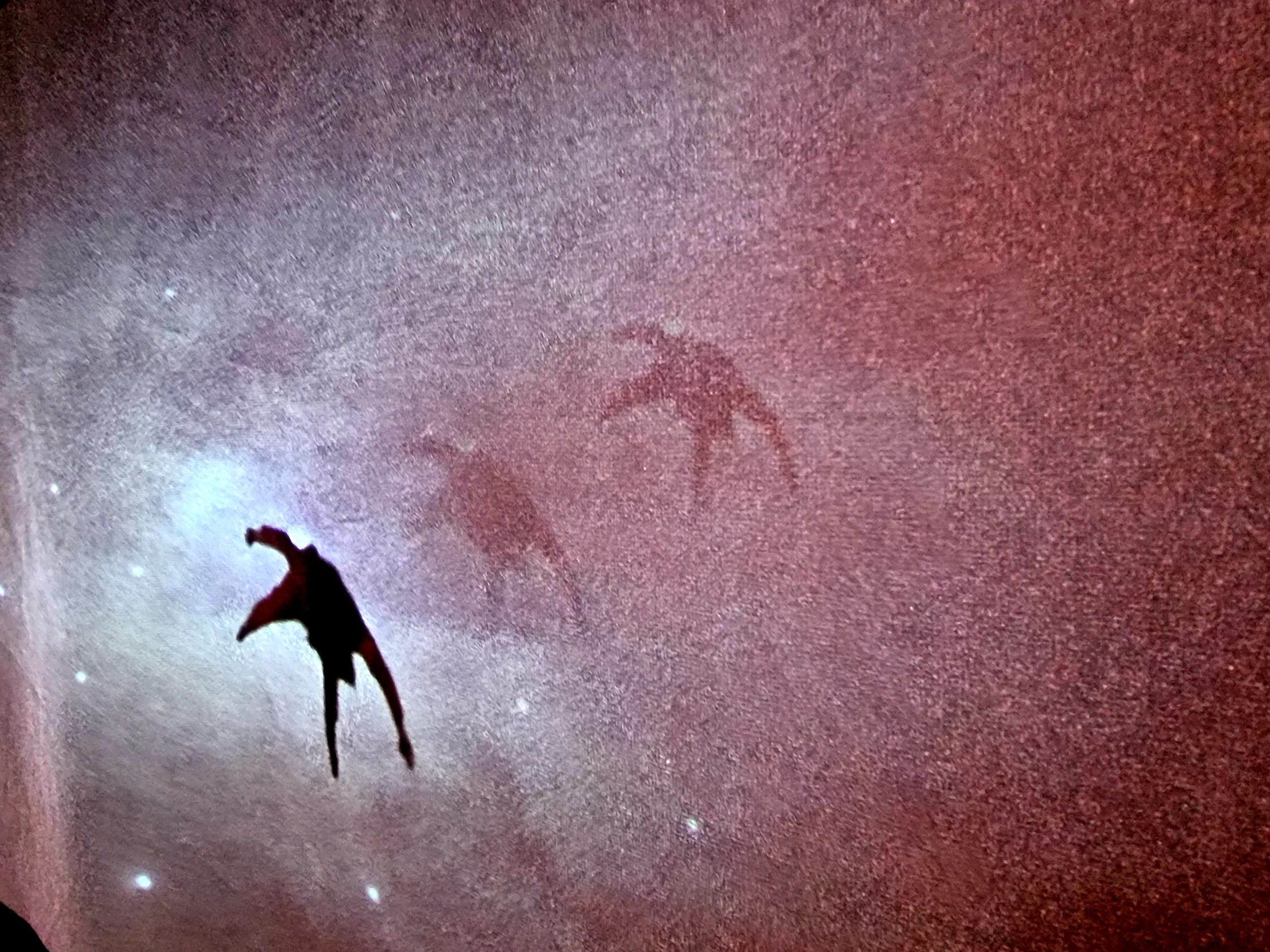7 Ways of Exploiting A Black Hole (2022)
A projection installation of 7-layered moving cinema holographs, created with black chiffon and black iridized glass, created for archival film and sound essay.
One day the sun will fail…
For my installation as part of the 2022 ensemble science exhibition FOREVERMORE FOREVERLESS, I chose to work with Dr. Adam Brown’s research on black hole “fishing” because of the seeming impossibility of the project – both in scientific/mathematical terms, as an impossible hypothetical exercise in astro-particle physics, and in terms of my own approach as a cinema artist. Fundamental concepts of cinema describe it as by definition a science of light, as well as a bringing-to-life (hence names for early cinema devices, such as Vitascope and Bioskop). Meanwhile, a black hole is described in the research as ‘more of a trap than a journey’; an inaccessible dark from which no energy or data can be sent back.
Initially I was therefore interested to understand how a black hole cinema might behave – thinking back to the poet Francis Ponge’s suggestions of cinema as dematerialisation, silhouette, eclipse, or as the void of the lost object. This was before stumbling on a key recent rhetoric of black holes: that they “are hiding movies of the Universe in their glowing rings” (explained in the words of radio astronomer Michael Johnson: ‘neglecting opacity, a telescope with the perfect resolution directed at a black hole observes an infinite number of nested images of the universe’). A black hole is the opposite of cinema: but it may still itself be the universe’s cinematic archive!
I was also struck by the language of Dr. Brown’s research: from ‘bubbles of nothing’ to ‘the fastest decay in the landscape’. Oddly, Brown often uses ‘they’ and ‘we’ interchangeably when discussing the eventuality of future humans needing to solve the logical problem of how to extract energy from a black hole. The questions always seemed to be how, logically, practically, and mathematically, to exploit a black hole – and never, whether to. This gave me the source of my project: the way in which the extremely alien languages of sci-fi and future science may be governed by extremely familiar languages of extraction and mining. The conceptual thrust at all costs seems to be a desire to learn to exploit the least exploitable thing in the known and unknown universe. I considered cinema in relation to these shimmering myths of extraction, with the black hole as their ultimate disappearing point.
The approach of this filmwork is shaped by clashing languages of a black hole. These include annotation and diagram in theoretical physics; the clinical language of mathematics; the romantic language of psychological yearning; the grandiosity of expedition and desperation of survival; and the warnings of poetic myth (Icarus). While I gathered plenty of text – even including strikingly emotional oral histories of the shrouded, pitch black The Black Hole rollercoaster (1984-2004) and its plummet/silhouette mechanic – I ended up deciding to go without captions or voiceover. Rather than having a “talking head” for a black hole, I preferred a non-didactic cinema, like a kind of ‘multiplex for the singularity’. This is the reason behind the mixed non-linear loops of film, soundscape, and black bookmarked silent reading materials.
It's hard to disconnect black holes from black hole pedagogy. Aesthetically this links to blackboards and chalkboards, where trajectories of thought are speculatively marked out in white and erased – like the threads of the Penrose Process, first theorised in 1971, aka, the lost art of fishing in a black hole, in which the whole sketch of energy sources in the event of our world’s future demise is kept aloft in geostationary orbit by the mooring of ropes in orbiting space, and by the complex relationship between ergosphere and rotational energy.
If Icarus is a Greek myth for its time about the hubris of earth system exploitation and ambition without sustainability (‘he waved his naked arms instead of wings, with no more feathers to sustain his flight’), then he also has this Anthropocene counterpart. The reading matters included show these types of imagination – such as Arthur C Clarke’s 1979 novel and its galactic mansions and space elevator thought experiment, described as ‘the lonely visions of an artist king’ and ‘the most grandiose engineering project of all time’. But they also address the more introverted experience, of a personal relationship with the black hole and its draw, and a soul facing the force of its own negation: it contains nothing really but a vision of an I that threatens to disintegrate. The soundscape’s eviscerated love lyric also aims to echo this intimate trajectory, as well as anthropocentric stories of our own resource starvation.
Ranging from cinematic séance to love songs, this film projection attempts to stage a suitable undoing of cinema. Materially, this is the opposite of a Pepper’s ghost illusion (1862), in that rather than being a ghost ‘brought to life’ by screen projection, what you see here is instead a lessening, like something expiring towards the vanishing point. This inverted cinema is inspired by my take on the astrophysics, and the black hole itself as a museum of untestable actions and extravagant exploitations. The excerpted films are drawn from archives, including, notably, the first feature film dedicated to a black hole, in 1979. This film was a blockbuster budget fiasco which was critically panned for the deficiencies of the shooting script. It also seemed to amount to a form of anti-cinema, defying the search for an ending or resolution. As the creators admitted afterwards, ‘We just kept shooting hoping that I would come up with an ending… ’
‘But that was it. They enter the black hole, end of movie.’








